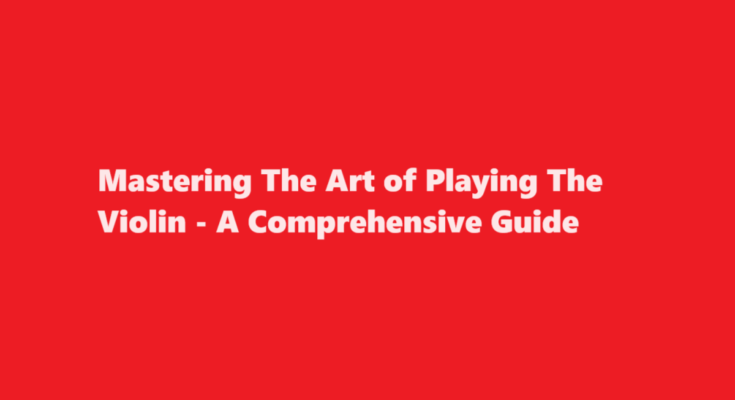The violin, with its elegant curves and soul-stirring melodies, has been captivating musicians and audiences for centuries. While it may appear daunting to learn, playing the violin is a rewarding journey that offers endless possibilities for self-expression and artistic growth. In this article, we will delve into the art of playing the violin, providing a step-by-step guide to help you embark on your musical adventure.
Getting Started
- Choosing the Right Violin The first step in learning to play the violin is to select the right instrument. Seek guidance from a knowledgeable teacher or a luthier, who can help you find a violin that suits your needs and budget.
- Essential Accessories Alongside your violin, you will need a bow, rosin, shoulder rest, and a case to protect your instrument. These accessories are crucial for the proper care and maintenance of your violin.
- Finding a Teacher Enrolling in violin lessons with a qualified instructor is essential for a successful journey. A teacher can guide you through the fundamentals, correct your technique, and provide motivation and constructive feedback.
Fundamentals of Playing
- Proper Posture Maintaining the correct posture is crucial for playing the violin. Stand or sit up straight, keeping your feet shoulder-width apart, and support the violin with your chin and shoulder rest.
- Holding the Bow Hold the bow with your right hand, fingers gently resting on the bow’s frog. Maintain a relaxed grip, as excessive tension can hinder your playing.
- Tuning Regularly tune your violin to ensure it produces accurate pitches. Tuning pegs and fine tuners on the tailpiece can be adjusted to achieve the desired pitch for each string (G, D, A, E).
- Basic Techniques Start with fundamental techniques such as bowing, pizzicato (plucking the strings), and fingering. Your teacher will guide you through these techniques, helping you to produce clear and beautiful sounds.
Practice and Patience
- Consistent PracticeBecoming proficient at playing the violin requires consistent and dedicated practice. Begin with short practice sessions and gradually increase the duration as your skills improve.
- Scales and Exercises Practice scales to build finger strength and dexterity. Exercises like scales and arpeggios are the building blocks of violin playing and should be a part of your daily practice routine.
- Listening and Repertoire Listen to professional violinists and explore a wide range of violin repertoire. Learning and playing pieces that inspire you will make practising more enjoyable.
Technique and Expression
- Bow Control Mastering bow control is vital for producing a variety of tones and dynamics. Experiment with bow speed, pressure, and contact point to achieve the desired expression in your music.
- Vibrato Vibrato is a beautiful technique that adds warmth and depth to your playing. Your teacher will guide you in developing this expressive technique.
- Articulation and Phrasing Pay attention to articulation, bowing patterns, and phrasing in your music. These elements contribute to your interpretation and expression of the piece.
Performance and Self-Expression
- Overcoming Stage Fright Performing can be intimidating, but it’s an essential part of your journey. Overcome stage fright by performing for friends and family, and gradually work your way up to larger audiences.
- Interpretation and Expression As you progress, aim to interpret the music with your unique voice. Inject your emotions and personality into your playing, making each performance a personal expression.
- Recording and Feedback Recording your practice sessions and performances can be a valuable tool for self-improvement. Analysing your recordings and seeking feedback from your teacher will help you refine your skills.
Maintenance and Care
- Cleaning and Rosining Regularly clean your violin, strings, and bow with a soft cloth. Apply rosin to the bow hair to maintain friction for a smooth sound production.
- String Replacement Violin strings wear out over time and may need to be replaced. Consult with a luthier or your teacher for guidance on selecting and changing strings.
- Climate Control Store your violin in a controlled environment to prevent damage due to extreme temperatures and humidity. Use a case with proper insulation to protect your instrument.
FREQUENTLY ASKED QUESTIONS
Is violin easy to learn?
As you may have now understood, a violin is the most difficult musical instrument to master. Some genius beginners seem to learn violin perfectly with just two to three years of practising. But mostly it takes much longer to become a master violin player.
Are violins hard to play?
It is true, the violin is one of the most difficult instruments to learn – and for good reason. While it only has four strings, it presents its own set of unique challenges for beginning violin players. Anyone who has ever tried to play the violin has struggled at some point along the way.
Conclusion
Learning to play the violin is a challenging but immensely rewarding journey. It requires dedication, patience, and a passion for music. Remember that progress may seem slow at times, but with consistent practice, the guidance of a qualified teacher, and a love for the instrument, you can become a skilled violinist.
The violin offers a lifetime of artistic exploration, allowing you to express your emotions and connect with others through music. Whether you aspire to play classical masterpieces, folk tunes, or contemporary pieces, the violin is a versatile instrument that can adapt to a wide range of musical genres. So, take the first step, and let the enchanting sounds of the violin be your guide on a musical adventure that will last a lifetime.
Read Also : A Step-by-Step Guide on How to Lace Vans Unveiling the Art of Expression



